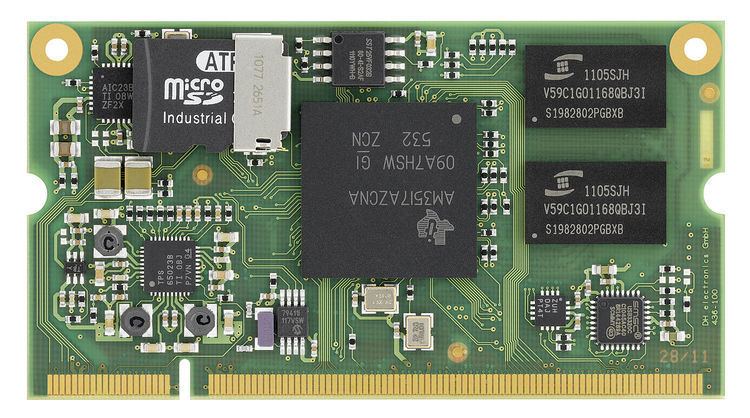 | ||
A computer-on-module (COM) is a type of single-board computer (SBC), a subtype of an embedded computer system. An extension of the concept of system on chip (SoC) and system in package (SiP), COM lies between a full-up computer and a microcontroller in nature. It is very similar to a system on module (SOM).
Contents
Design
COMs are complete embedded computers built on a single circuit board. An extension of the concept of System on Chip (SoC), COM lies between a full-up computer and a microcontroller. The design is centered on a microprocessor with RAM, input/output controllers and all other features needed to be a functional computer on the one board. However, unlike a single-board computer, the COM usually lacks the standard connectors for any input/output peripherals to be attached directly to the board.
The module usually needs to be mounted on a carrier board (or "baseboard") which breaks the bus out to standard peripheral connectors. Some COMs also include peripheral connectors. Some can be used without a carrier.
A COM solution offers a dense package computer system for use in small or specialized applications requiring low power consumption or small physical size as is needed in embedded systems. As a COM is very compact and highly integrated, even complex CPUs, including multi-core technology, can be realized on a COM.
Using a carrier board is a benefit in many cases, as it can implement special I/O interfaces, memory devices, connectors or form factors. Separating the design of the carrier board and COM makes design concepts more modular, if needed. A carrier tailored to a special application may involve high design overhead by itself. If the actual processor and main I/O controllers are located on a COM, it is much easier, for example, to upgrade a CPU component to the next generation, without having to redesign a very specialized carrier as well. This can save costs and shorten development times. On the other hand, this only works if the board-to-board connection between the COM and its carrier remains compatible between upgrades.
Some devices also incorporate field-programmable gate array (FPGA) components. FPGA-based functions can be added as IP cores to the COM itself or to the carrier card. Using FPGA IP cores adds to the modularity of a COM concept, because I/O functions can be adapted to special needs without extensive rewiring on the printed circuit board.
History
The terms "Computer-on-Module" and "COM" were coined by VDC Research Group, Inc. (formerly Venture Development Corporation) to describe this class of embedded computer boards.
Dr. Gordon Kruberg, founder and CEO of Gumstix, created the first COM. Gumstix's ARM Linux Machine is #373 and dated September 9, 2003, as compared to the next recognizable COM's entry of #735 dated April 18, 2005, a gap of over 19 months. Note that boards numbered below 373 were larger, single board computers as opposed to modules, for example, the Itsy, a tiny hand-held device based on the StrongARM.
The rapid development paradigm (COM + expansion board) Dr. Kruberg established has been at the heart of leading edge development since then and has proven useful in launching entire industries requiring rapid development efforts, for example, Apple Inc. used a Gumstix COM to test original iPhone concept in 2005.
The term became more notable upon industry standardization of the COM Express format.
Benefits of computer modules
There are many benefits to using COM products instead of ground-up development. These benefits include increasing speed to market (TTM), reduction in risk, cost savings, choice of a variety of CPUs, reduced requirements and time for customer design, and an ability to conduct both hardware and software development at once.
